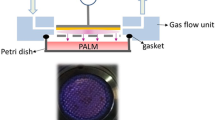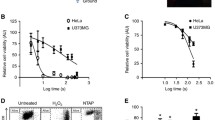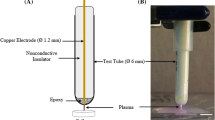Abstract
Non-thermal atmospheric pressure dielectric barrier discharge (DBD) plasma may provide a novel approach to treat malignancies via induction of apoptosis. The purpose of this study was to evaluate the potential of DBD plasma to induce apoptosis in melanoma cells. Melanoma cells were exposed to plasma at doses that did not induce necrosis, and cell viability and apoptotic activity were evaluated by Trypan blue exclusion test, Annexin-V/PI staining, caspase-3 cleavage, and TUNEL® analysis. Trypan blue staining revealed that non-thermal plasma treatment significantly decreased the viability of cells in a dose-dependent manner 3 and 24 h after plasma treatment. Annexin-V/PI staining revealed a significant increase in apoptosis in plasma-treated cells at 24, 48, and 72 h post-treatment (p < 0.001). Caspase-3 cleavage was observed 48 h post-plasma treatment at a dose of 15 J/cm2. TUNEL® analysis of plasma-treated cells demonstrated an increase in apoptosis at 48 and 72 h post-treatment (p < 0.001) at a dose of 15 J/cm2. Pre-treatment with N-acetyl-l-cysteine (NAC), an intracellular reactive oxygen species (ROS) scavenger, significantly decreased apoptosis in plasma-treated cells at 5 and 15 J/cm2. Plasma treatment induces apoptosis in melanoma cells through a pathway that appears to be dependent on production of intracellular ROS. DBD plasma production of intracellular ROS leads to dose-dependent DNA damage in melanoma cells, detected by γ-H2AX, which was completely abrogated by pre-treating cells with ROS scavenger, NAC. Plasma-induced DNA damage in turn may lead to the observed plasma-induced apoptosis. Since plasma is non-thermal, it may be used to selectively treat malignancies.








Similar content being viewed by others
References
Berk, L. B. Radiation therapy as primary and adjuvant treatment for local and regional melanoma. Cancer Control 15(3):233–238, 2008.
Colt, H. G., and S. W. Crawford. In vitro study of the safety limits of bronchoscopic argon plasma coagulation in the presence of airway stents. Respirology 11(5):643–647, 2006.
Coulombe, S. Live cell permeabilization using the APGD-t. In: 1st International Conference on Plasma Medicine (ICPM), Corpus Christi, TX, 2007.
Coulombe, S., et al. Miniature atmospheric pressure glow discharge torch (APGD-t) for local biomedical applications. Pure Appl. Chem. 78(6):1137–1146, 2006.
Eliasson, B., W. Egli, and U. Kogelschatz. Modelling of dielectric barrier discharge chemistry. Pure Appl. Chem. 66(6):1275–1286, 1994.
Eton, O. Chemotherapy, cytokines, and biochemotherapy for melanoma. Cancer Chemother. Biol. Response Modif. 22:739–748, 2005.
Fiers, W., et al. More than one way to die: apoptosis, necrosis and reactive oxygen damage. Oncogene 18(54):7719–7730, 1999.
Flaherty, K. T. Chemotherapy and targeted therapy combinations in advanced melanoma. Clin. Cancer Res. 12(Pt 2):2366–2370, 2006.
Fridman, A. Plasma biology and plasma medicine. In: Plasma Chemistry. New York, NY: Cambridge University Press, 2008, pp. 848–857.
Fridman, A. Plasma Chemistry. New York, NY: Cambridge University Press, 2008.
Fridman, A. Plasma Biology and Plasma Medicine. New York: Cambridge University Press, 2008.
Fridman, A., A. Chirokov, and A. Gutsol. Non-thermal atmospheric pressure discharges. J. Phys. D: Appl. Phys. 38:R1–R24, 2005.
Fridman, A. and L. A. Kennedy. Plasma Physics and Engineering. New York: Routledge, 2004, 853 pp.
Fridman, G., et al. Blood coagulation and living tissue sterilization by floating-electrode dielectric barrier. Disch. Air Plasma Chem. Plasma Process. 26(4):425–442, 2006.
Fridman, G., et al. Comparison of direct and indirect effects of non-thermal atmospheric-pressure plasma on bacteria. Plasma Process. Polym. 4(4):370–375, 2007.
Gebicki, S., and J. M. Gebicki. Formation of peroxides in amino acids and proteins exposed to oxygen free radicals. Biochem. J. 289(Pt 3):743–749, 1993.
Ginsberg, G. G., et al. The argon plasma coagulator: February 2002. Gastrointest. Endosc. 55(7):807–810, 2002.
Goree, J., L. Bin, D. Drake, and E. Stoffels. Killing of S. mutans bacteria using a plasma needle at atmospheric pressure. IEEE Trans Plasma Sci 34(4):1317–1324, 2006.
Gostev, V. and D. Dobrynin. Medical microplasmatron. In: 3rd International Workshop on Microplasmas (IWM-2006), Greifswald, Germany, 2006.
Hu, W., and J. J. Kavanagh. Anticancer therapy targeting the apoptotic pathway. Lancet Oncol. 4(12):721–729, 2003.
Jaattela, M. Programmed cell death: many ways for cells to die decently. Ann. Med. 34(6):480–488, 2002.
Kalghatgi, S., et al. Applications of non thermal atmospheric pressure plasma in medicine. In: NATO Advanced Study Institute on Plasma Assisted Decontamination of Biological and Chemical Agents. Cesme-Izmir, Turkey: Springer, 2007.
Kalghatgi, S., et al. Mechanism of blood coagulation by nonthermal atmospheric pressure dielectric barrier discharge plasma. IEEE Trans. Plasma Sci. 35(5):1559–1566, 2007.
Kalghatgi, S., et al. Penetration of direct non-thermal plasma treatment into living cells. In: IEEE 35th International Conference on Plasma Science, Karlsruhe, Germany, 2008.
Kalghatgi, S., et al. Toxicity analysis of direct non-thermal plasma treatment of living tissue. In: IEEE 35th International Conference on Plasma Science, Karlsruhe, Germany, 2008.
Kalghatgi, S., et al. Toxicity of non-thermal plasma treatment of endothelial cells. In: IEEE 35th International Conference on Plasma Science, Karlsruhe, Germany, 2008.
Kalghatgi, S. U., et al. Non-thermal dielectric barrier discharge plasma treatment of endothelial cells. In: 30th Annual International Conference of the IEEE Engineering in Medicine and Biology Society. Vancouver, BC, Canada: Inst. of Elec. and Elec. Eng. Computer Society, 2008.
Kalghatgi, S., et al. On the interaction of non-thermal atmospheric pressure plasma with tissues. In: Proceedings of the IEEE 17th International Pulsed Power Conference, Washington, DC, 2009.
Kalghatgi, S., et al. Toxicity of direct non-thermal atmospheric pressure plasma treatment of living tissue. In: Proceedings of the IEEE 17th International Pulsed Power Conference, Washington DC, 2009.
Kalghatgi, S., et al. Endothelial cell proliferation is enhanced by low dose non-thermal plasma through fibroblast growth factor-2 release. Ann. Biomed. Eng. 38(3):748–757, 2010.
Kawiak, A., et al. Induction of apoptosis by plumbagin through reactive oxygen species-mediated inhibition of topoisomerase II. Toxicol. Appl. Pharmacol. 223(3):267–276, 2007.
Kieft, I. E., M. Kurdi, and E. Stoffels. Reattachment and apoptosis after plasma-needle treatment of cultured cells. IEEE Trans. Plasma Sci. 34(4):1331–1336, 2006.
Kieft, I. E., et al. Plasma treatment of mammalian vascular cells: a quantitative description. IEEE Trans. Plasma Sci. 33(2):771–775, 2005.
Kogelschatz, U., et al. Non-Equilibrium Air Plasmas at Atmospheric Pressure. 1st ed. Plasma Physics. London: Taylor & Francis, 2004.
Kuo, S. P., O. Tarasenko, S. Popovic, and K. Levon. Killing of bacterial spores contained in a paper envelope by a microwave plasma torch. IEEE Trans. Plasma Sci. 34(4):1275–1280, 2006.
Laroussi, M. Low temperature plasma-based sterilization: overview and state-of-the-art. Plasma Process. Polym. 2:391–400, 2005.
Laroussi, M., I. Alexeff, and W. L. Kang. Biological decontamination by nonthermal plasmas. IEEE Trans. Plasma Sci. 28(1):184–188, 2000.
Laroussi, M., and F. Leipold. Evaluation of the roles of reactive species, heat, and UV radiation in the inactivation of bacterial cells by air plasmas at atmospheric pressure. Int. J. Mass Spectrom. 233(1–3):81–86, 2004.
Laroussi, M., D. A. Mendis, and M. Rosenberg. Plasma interaction with microbes. New J. Phys. 5:41.1–41.10, 2003.
Laroussi, M., et al. Inactivation of bacteria by the plasma pencil. Plasma Process. Polym. 3(6–7):470–473, 2006.
Lehnert, B. E., and R. Iyer. Exposure to low-level chemicals and ionizing radiation: reactive oxygen species and cellular pathways. Hum. Exp. Toxicol. 21(2):65–69, 2002.
Léveillé, V., and S. Coulombe. Design and preliminary characterization of a miniature pulsed RF APGD torch with downstream injection of the source of reactive species. Plasma Sources Sci. Technol. 14:467–476, 2005.
Lord, M. J., J. A. Maltry, and L. M. Shall. Thermal injury resulting from arthroscopic lateral retinacular release by electrocautery: report of three cases and a review of the literature. Arthroscopy 7(1):33–37, 1991.
Majno, G., and I. Joris. Apoptosis, oncosis, and necrosis. An overview of cell death. Am. J. Pathol. 146(1):3–15, 1995.
Mandara, M., et al. Chemotherapy for metastatic melanoma. Expert Rev. Anticancer Ther. 6(1):121–130, 2006.
Nuccitelli, R., et al. A new pulsed electric field therapy for melanoma disrupts the tumor’s blood supply and causes complete remission without recurrence. Int. J. Cancer 125(2):438–445, 2009.
Pak, B. J., et al. Radiation resistance of human melanoma analysed by retroviral insertional mutagenesis reveals a possible role for dopachrome tautomerase. Oncogene 23(1):30–38, 2004.
Porter, K. A., et al. Electrocautery as a factor in seroma formation following mastectomy. Am. J. Surg. 176(1):8–11, 1998.
Puhlev, I., et al. Desiccation tolerance in human cells. Cryobiology 42(3):207–217, 2001.
Raiser, J., and M. Zenker. Argon plasma coagulation for open surgical and endoscopic applications: state of the art. J. Phys. D: Appl. Phys. 39(16):3520, 2006.
Rappaport, W. D., et al. Effect of electrocautery on wound healing in midline laparotomy incisions. Am. J. Surg. 160(6):618–620, 1990.
Rath, P. C., and B. B. Aggarwal. TNF-induced signaling in apoptosis. J. Clin. Immunol. 19(6):350–364, 1999.
Ratha, J., et al. Attenuated Leishmanial sphingolipid induces apoptosis in A375 human melanoma cell via both caspase-dependent and -independent pathways. Mol. Cell. Biochem. 304(1–2):143–154, 2007.
Reed, J. C. Apoptosis-based therapies. Nat. Rev. Drug. Discov. 1(2):111–121, 2002.
Rogakou, E., et al. DNA double-stranded breaks induce histone H2AX phosphorylation on serine 139. J. Biol. Chem. 273:5858–5868, 1998.
Schild, S. E. Role of radiation therapy in the treatment of melanoma. Expert Rev. Anticancer Ther. 9(5):583–586, 2009.
Sharma, A., A. Pruden, O. Stan, G. J. Collins. Bacterial inactivation using an RF-powered atmospheric pressure plasma. IEEE Trans. Plasma Sci. 34(4), 2006.
Shekhter, A. B., et al. Beneficial effect of gaseous nitric oxide on the healing of skin wounds. Nitric Oxide Biol. Chem. 12(4): 210–219, 2005.
Siemens, C. W. On the electrical tests employed during the construction of the Malta and Alexandria telegraph, and on insulating and protecting submarine cables. J. Frankl. Inst. 74(3):166–170, 1862.
Simmons, P. D., F. Langlet, and R. N. Thin. Cryotherapy versus electrocautery in the treatment of genital warts. Br. J. Vener. Dis. 57(4):273–274, 1981.
Sladek, R. E. J., and E. Stoffels. Deactivation of Escherichia coli by the plasma needle. J. Phys. D: Appl. Phys. 38:1716–1721, 2005.
Soengas, M. S., and S. W. Lowe. Apoptosis and melanoma chemoresistance. Oncogene 22(20):3138–3151, 2003.
Stevens, G., and A. Hong. Radiation therapy in the management of cutaneous melanoma. Surg. Oncol. Clin. N. Am. 15(2):353–371, 2006.
Stoffels, E. Gas plasmas in biology and medicine. J. Phys. D: Appl. Phys. 39(16), 2006.
Stoffels, E., et al. Plasma needle for in vivo medical treatment: recent developments and perspectives. Plasma Sources Sci. Technol. 15(4):S169–S180, 2006.
Stoffels, E., et al. Cold gas plasma in biology and medicine. In: Advanced Plasma Technology, edited by R. d’Agostino. Weinheim: Wiley-VCH, 2008, pp. 301–318.
Tarasenko, O., S. Nourbakhsh, S. P. Kuo, A. Bakhtina, P. Alusta, D. Kudasheva, M. Cowman, and K. Levon. Scanning electron and atomic force microscopy to study plasma torch effects on B. cereus Spores. IEEE Trans. Plasma Sci. 34(4):1281–1289, 2006.
Vargo, J. J. Clinical applications of the argon plasma coagulator. Gastrointest. Endosc. 59(1):81–88, 2004.
Williamson, J. M., D. D. Trump, P. Bletzinger, and B. N. Ganguly. Comparison of high-voltage ac and pulsed operation of a surface dielectric barrier discharge. J. Phys. D: Appl. Phys. 39:4400–4406, 2006.
Yang, J., Y. Su, and A. Richmond. Antioxidants tiron and N-acetyl-l-cysteine differentially mediate apoptosis in melanoma cells via a reactive oxygen species-independent NF-kappaB pathway. Free Radic. Biol. Med. 42(9):1369–1380, 2007.
Zafarullah, M., et al. Molecular mechanisms of N-acetylcysteine actions. Cell. Mol. Life Sci. 60(1):6–20, 2003.
Zhang, R., L. Wang, Y. Wu, Z. Guan, and Z. Jia. Bacterial decontamination of water by bipolar pulsed discharge in a gas; liquid; solid three-phase discharge reactor. IEEE Trans. Plasma Sci. 34(4):1370–1374, 2006.
Acknowledgments
We would like to acknowledge Monica Jost for her help and guidance with the TUNEL assay and Dr. Christian Sell for allowing us to use his flow cytometer to carry out the Annexin-V/PI assay.
Author information
Authors and Affiliations
Corresponding author
Additional information
Associate Editor Bahman Anvari oversaw the review of this article.
The first two authors have contributed equally to this work.
A retraction note to this article is available at http://dx.doi.org/10.1007/s10439-013-0740-7.
This article is being retracted due to the discovery of identical data in the following publication by Fridman et al.: (Plasma Chem Plasma Process (2007) 27:163-176; DOI: 10.1007/s11090-007-9048-4).
An erratum to this article is available at http://dx.doi.org/10.1007/s10439-013-0740-7.
About this article
Cite this article
Sensenig, R., Kalghatgi, S., Cerchar, E. et al. RETRACTED ARTICLE: Non-thermal Plasma Induces Apoptosis in Melanoma Cells via Production of Intracellular Reactive Oxygen Species. Ann Biomed Eng 39, 674–687 (2011). https://doi.org/10.1007/s10439-010-0197-x
Received:
Accepted:
Published:
Issue Date:
DOI: https://doi.org/10.1007/s10439-010-0197-x




